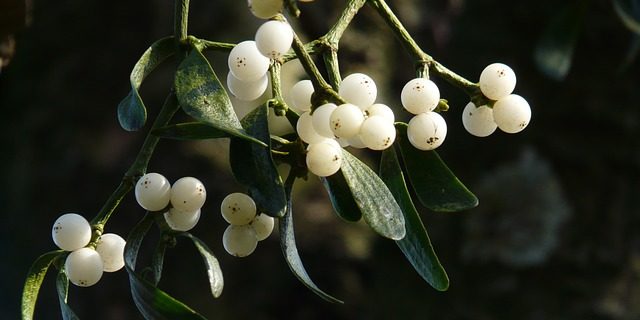Mistletoe has been part of human culture and medicine for millennia, appearing in mythologies and medicine books across the world. There are hundreds varieties of mistletoe with different medicinal qualities, and today the focus is on the European variety, Viscum album– Viscum for the viscous stickiness of mistletoe berries, and album for their whiteness.
Before much can be said about mistletoe as a medicinal herb, it must be noted that mistletoe is an herb with a high toxicity. It should be used in small, prepared doses under the guidance of a qualified healthcare practitioner. That being said, mistletoe is full of medicine!
Mistletoe for the heart: Mistletoe regulates the heart beat and strengthens the capillary walls, encouraging good circulation. It is often used in the treatment of high blood pressure for these reasons, and its soothing, calming effect on the nerves is an added bonus. Because mistletoe strengthens the capillary walls and dilates the blood vessels, it an excellent herb for arteriosclerosis and angina.
Mistletoe is especially helpful for slowing a rapid heart-rate due to nervousness. In a similar vein, it eases the headaches brought on by blood pressure fluctuations and palpitations.
Mistletoe for the nerves: Mistletoe is a powerful nervine, sedative, and muscle relaxant. It soothes, tones, and quiets the nervous system. It has been used successfully in the treatment of anxiety, panic attacks, insomnia, and nervous palpitations. It also has a long history of use in the treatment of convulsive disorders, including epilepsy.
The flower essence of Mistletoe encourages transformation; it is recommended for people undergoing radical change in their lives, as it increases resiliency to stress and encourages a calm and steady mind.
Mistletoe for immunity: Mistletoe is being researched for its activating effects on the immune system, as well as for constituents within the herb that may have anti-tumor effects.
Mistletoe is a parasitic plant that grows high in the branches of certain trees. In Europe it seems to favor poplar, spruce, pine, chestnut, and fruit trees. It tends to grow on trees that are at least 20 years old, and it doesn’t tend to kill them. Birds love the sticky white berries, which are poisonous to us, and they are mistletoe’s chief vehicle for reproduction. As for us, we use only the young, leafy twigs for medicine. They are gathered in the spring and must be dried before they can be used.
In the ancient Druidic culture, mistletoe was gathered at the beginning of winter and hung in doorways for protection, good fortune, and restful sleep. It is a wonderful herb for nourishing the heart and mind through the winter months. Here’s to the season!








